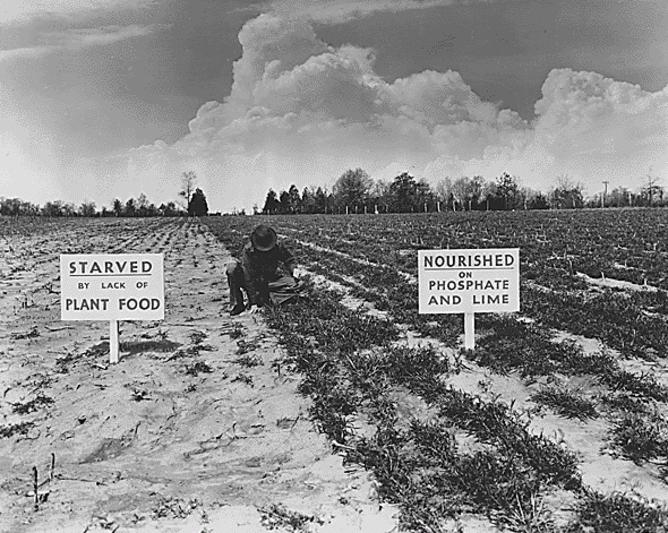How the Great Phosphorus Shortage Could Leave Us All Hungry
Published on by Naizam (Nai) Jaffer, Municipal Operations Manager (Water, Wastewater, Stormwater, Roads, & Parks) in Academic
You know that greenhouse gases are changing the climate. You probably know drinking water is becoming increasingly scarce, and that we’re living through a mass extinction.
But when did you last worry about phosphorus?
It’s not as well-known as the other issues, but phosphorus depletion is no less significant. After all, we could live without cars or unusual species, but if phosphorus ran out we’d have to live without food.
Phosphorus is an essential nutrient for all forms of life. It is a key element in our DNA and all living organisms require daily phosphorus intake to produce energy. It cannot be replaced and there is no synthetic substitute: without phosphorus, there is no life.
Our dependence began in the mid-19th century, after farmers noticed spreading phosphorus-rich guano (bird excrement) on their fields led to impressive improvements in crop yields. Soon after, mines opened up in the US and China to extract phosphate ore – rocks which contain the useful mineral. This triggered the current use of mineral fertilisers and, without this industrial breakthrough, humanity could only produce half the food that it does today.
Fertiliser use has quadrupled over the past half century and will continue rising as the population expands. The growing wealth of developing countries allows people to afford more meat which has a “phosphorus footprint” 50 times higher than most vegetables. This, together with the increasing usage of biofuels, is estimated to double the demand for phosphorus fertilisers by 2050.
Today phosphorus is also used in pharmaceuticals, personal care products, flame retardants, catalysts for chemical industries, building materials, cleaners, detergents and food preservatives.
Phosphorus is not a renewable resource
Reserves are limited and not equally spread over the planet. The only large mines are located in Morocco, Russia, China and the US. Depending on which scientists you ask, the world’s phosphate rock reserves will last for another 35 to 400 years – though the more optimistic assessments rely on the discovery of new deposits.
It’s a big concern for the EU and other countries without their own reserves, and phosphorus depletion could lead to geopolitical tensions. Back in 2008, when fertiliser prices sharply increased by 600% and directly influenced food prices, there were violent riots in 40 different developing countries.
Phosphorus also harms the environment. Excessive fertiliser use means it leaches from agricultural lands into rivers and eventually the sea, leading to so-called dead zones where most fish can’t survive. Uninhibited algae growth caused by high levels of phosphorus in water has already created more than 400 coastal death zones worldwide. Related human poisoning costs US$2.2 billion dollars annually in the US alone.
With the increasing demand for phosphorus leading to massive social and environmental issues, it’s time we looked towards more sustainable and responsible use.
Attached link
https://theconversation.com/how-the-great-phosphorus-shortage-could-leave-us-all-hungry-54432Taxonomy
- Fertilizers
- Crop Farming
- Fertilizer
- Fertilizer
1 Comment
-
Effluent Polishing Consultant
Portable onsite & emergence Filtration equipment for Industry and Municipal Sewage Lagoon release
Phosphorus is highly concentrated in plant seeds (grains), animals and animal (and human) excrements.
Consequently environments with intensive animal production or high population density receive a surplus of P that commonly causes environmental pollution.
Urea, also called carbamide, Biochemistry. a compound, CO(NH 2) 2, is an organic chemical compound, and is essentially the waste produced by the body after metabolizing protein. Naturally, the compound is produced when the liver breaks down protein or amino acids, and ammonia; the kidneys then transfer the urea from the blood to the urine. Extra nitrogen is expelled from the body through urea, and because it is extremely soluble, it is a very efficient process. The average person excretes about 30 grams of urea a day, mostly through urine, but a small amount is also secreted in perspiration. Synthetic versions of the chemical compound can be created in liquid or solid form, and is often an ingredient found in fertilizers, animal feed, and diuretics, just to name a few.
Most of the manufactured compound is used in fertilizers; when nitrogen is added to urea, the compound becomes water soluble, making it a highly desired ingredient for lawn fertilizer. The synthetic version is also used commercially and industrially to produce some types of plastics, animal feed, glues, toilet bowl cleaners, dish washing machine detergents, hair coloring products, pesticides, and fungicides. Medicinally, it is used in barbiturates, dermatological products that re-hydrate the skin, and diuretics
Organic-P Organic phosphorus can be converted to orthophosphate and polyphosphate, some organics degrade very slowly
Orthophosphate Most abundant phosphorus species Reactive species in chemical reactions and consumed in biological growth
Polyphosphates Condensed orthophosphates Possibly reacts with metal salts Can be used for biological growth Chemical phosphorus Precipitated phosphates formed by reacting orthophosphate with metal salts, or precipitates as phosphate hydroxides Biological phosphorus
Phosphorus incorporated into the biomass for growth Excess phosphorus may accumulate under certain conditions